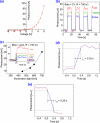Ternary TiO2/MoS2/ZnO hetero-nanostructure based multifunctional sensing devices
- PMID: 39331285
- PMCID: PMC11436549
- DOI: 10.1186/s11671-024-04112-7
Ternary TiO2/MoS2/ZnO hetero-nanostructure based multifunctional sensing devices
Abstract
Novel sensing applications benefit from multifunctional nanomaterials responsive to various external stimuli such as mechanics, electricity, light, humidity, or pollution. While few such materials occur naturally, the careful design of synergized nanomaterials unifies the cross-coupled properties which are weak or absent in single-phase materials. In this study, 2D MoS2 integrated with ultrathin dielectric oxide layers forms hetero-nanostructures with significant impacts on carrier transport. The ternary TiO2/MoS2/ZnO hetero-nanostructures, along with their individual properties, improve the performance of multifunctional sensing devices. The synthesized hetero-nanostructure exhibits a responsivity of up to 16 mA/W to 700 nm light and responds to 5 ppm ammonia gas at room temperature. These enhancements are attributed to interface charge transfer and photogating effects. The ternary TiO2/MoS2/ZnO hetero-nanostructure is compatible with existing semiconductor fabrication technologies, making it feasible to integrate into flexible, lightweight semiconductor devices and circuits. These results may inspire new photodetectors and sensing devices based on two-dimensional (2D) layered materials for IoT applications.
Keywords: Gas sensor; Molybdenum disulfide; Multifunctional sensor; Photodetector; Ternary hetero-nanostructure; Titanium dioxide; Two-dimensional material; Zinc oxide.
© 2024. The Author(s).
Conflict of interest statement
The authors declare no competing interests.
Figures







Similar articles
-
Highly Selective Room-Temperature Blue LED-Enhanced NO2 Gas Sensors Based on ZnO-MoS2-TiO2 Heterostructures.Sensors (Basel). 2025 Mar 13;25(6):1781. doi: 10.3390/s25061781. Sensors (Basel). 2025. PMID: 40292913 Free PMC article.
-
Design of Hetero-Nanostructures on MoS2 Nanosheets To Boost NO2 Room-Temperature Sensing.ACS Appl Mater Interfaces. 2018 Jul 5;10(26):22640-22649. doi: 10.1021/acsami.8b05811. Epub 2018 Jun 25. ACS Appl Mater Interfaces. 2018. PMID: 29896961
-
Fabrication of Pd-decorated TiO2/MoS2 ternary nanocomposite for enhanced benzene gas sensing performance at room temperature.Talanta. 2018 May 15;182:324-332. doi: 10.1016/j.talanta.2018.01.064. Epub 2018 Feb 1. Talanta. 2018. PMID: 29501160
-
Wearable and Implantable Soft Bioelectronics Using Two-Dimensional Materials.Acc Chem Res. 2019 Jan 15;52(1):73-81. doi: 10.1021/acs.accounts.8b00491. Epub 2018 Dec 26. Acc Chem Res. 2019. PMID: 30586292 Review.
-
A review of molybdenum disulfide (MoS2) based photodetectors: from ultra-broadband, self-powered to flexible devices.RSC Adv. 2020 Aug 19;10(51):30529-30602. doi: 10.1039/d0ra03183f. eCollection 2020 Aug 17. RSC Adv. 2020. PMID: 35516069 Free PMC article. Review.
Cited by
-
Type II ZnO-MoS2 Heterostructure-Based Self-Powered UV-MIR Ultra-Broadband p-n Photodetectors.Molecules. 2025 Feb 26;30(5):1063. doi: 10.3390/molecules30051063. Molecules. 2025. PMID: 40076288 Free PMC article.
-
Zinc Oxide/Molybdenum Disulfide as Nanocomposite for Multifunctional Sensor Prototype.Micromachines (Basel). 2025 Mar 21;16(4):358. doi: 10.3390/mi16040358. Micromachines (Basel). 2025. PMID: 40283235 Free PMC article.
-
Recent Progress in Photodetectors: From Materials to Structures and Applications.Micromachines (Basel). 2024 Oct 11;15(10):1249. doi: 10.3390/mi15101249. Micromachines (Basel). 2024. PMID: 39459123 Free PMC article. Review.
-
Highly Selective Room-Temperature Blue LED-Enhanced NO2 Gas Sensors Based on ZnO-MoS2-TiO2 Heterostructures.Sensors (Basel). 2025 Mar 13;25(6):1781. doi: 10.3390/s25061781. Sensors (Basel). 2025. PMID: 40292913 Free PMC article.
References
-
- Wang J, Lim MK, Wang C, Tseng ML. The evolution of the Internet of Things (IoT) over the past 20 years. Comput Ind Eng. 2021;155:107174.
-
- Jamshed MA, Ali K, Abbasi QH, Imran MA, Ur-Rehman M. Challenges, applications, and future of wireless sensors in Internet of Things: a review. IEEE Sens J. 2022;22(6):5482–94.
-
- Aslam A, Mehmood U, Arshad MH, Ishfaq A, Zaheer J, Khan AUH, Sufyan M. Dye-sensitized solar cells (DSSCs) as a potential photovoltaic technology for the self-powered internet of things (IoTs) applications. Sol Energy. 2020;207:874–92.
-
- Yang Y, Guo X, Zhu M, Sun Z, Zhang Z, He T, Lee C. Triboelectric nanogenerator enabled wearable sensors and electronics for sustainable internet of things integrated green earth. Adv Energy Mater. 2023;13(1):2203040.
-
- Portilla L, Loganathan K, Faber H, Eid A, Hester JG, Tentzeris MM, Fattori M, Cantatore E, Jiang C, Nathan A, Fiori G. Wirelessly powered large-area electronics for the Internet of Things. Nat Electronics. 2023;6(1):10–7.
Grants and funding
LinkOut - more resources
Full Text Sources
